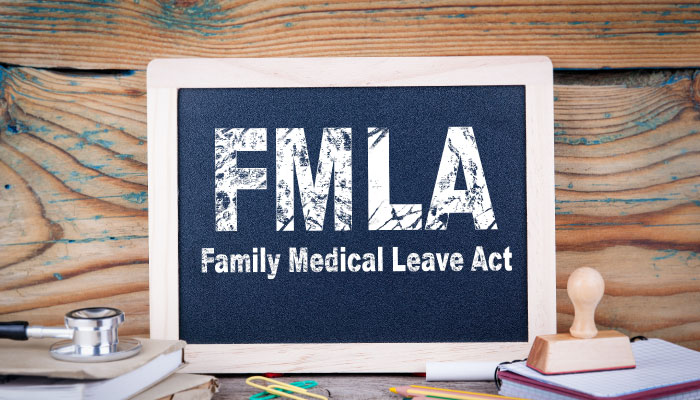Best practices include vigilance, policies, and training
The Family and Medical Leave Act (FMLA) provides for unpaid, job-protected leave and continued group health insurance coverage for certain family and medical reasons. But that’s just the synopsis—the Act has a lot of details that you must know to remain in compliance. For example, does your company even qualify as a covered employer? And if so, which of your employees are eligible? Deciphering these details will help you get a handle on fulfilling the requirement for your employees’ leave, and also avoid fines and possible litigation. So Boost FMLA Compliance & deter abuse.
Determine Your Eligibility
According to the Department of Labor, “FMLA applies to all public agencies, all public and private elementary and secondary schools, and companies with 50 or more employees.”
Not so fast: But even if FMLA applies to your company, not all employees will be eligible for benefits. To meet the eligibility requirements, an employee must:
- Have worked for their employer for at least 12 months,
- Have worked a minimum of 1,250 hours during those 12 months; and
- Work at a location where the company employs 50 or more employees within 75 miles.
Tip: The DOL published The Family and Medical Leave Act Employer Guide, which can serve as a handy reference for your Human Resources (HR) department.
Deter FMLA Abuse
Unfortunately, FMLA abuse is a real thing. Who couldn’t use 12 weeks off?! Employees may take advantage of the leave, using it for personal pleasure (such as a vacation) or personal gain (such as another job or a start-up venture). Also, intermittent leave poses its own challenges.
The United States Department of Labor (DOL) states, “When it is medically necessary, employees may take FMLA leave intermittently–taking leave in separate blocks of time for a single qualifying reason–or on a reduced leave schedule–reducing the employee’s usual weekly or daily work schedule.”
Problem: An SHRM report revealed that not only is tracking intermittent leave challenging, but chronic abuse of intermittent leave by employees is prevalent, with 66 percent of HR professionals reporting this problem.
Solutions: To limit the abuse of intermittent FMLA leave, SHRM states that employers should:
- Evaluate and understand the regulations;
- Closely monitor FMLA leave for abuse patterns;
- Develop a policy within the guidelines of the regulations;
- Take action with the employee when necessary; and
- Hold the employee accountable for complying with the specifications described in the certification.
Remain Vigilant For Compliance
“For human resources professionals and supervisors, the challenge is how to comply with the law’s intent and specific provisions without allowing significant numbers of employees to game the system,” stated the employment law firm Fisher & Phillips, LLP. The firm offered four tips to help meet both goals:
- Ensure that your polices and practices are up-to-date and compliant. Employers are responsible for detailed, ongoing communication with employees requesting or taking FMLA leave. This helps confirm employee eligibility and the employee’s understanding of his rights and responsibilities while taking leave.
- Train supervisors to spot and respond to potential FMLA situations. The supervisor should develop a standard reporting practice to HR regarding any employee that might need to utilize FMLA. But supervisors should not question employees about their medical condition or contact the employee’s medical provider (that’s HR’s job!), and they must never discipline or terminate an employee for any absence that may be covered by the FMLA.
- Destigmatize the FMLA. Use new-employee orientation, follow-up training, policies, and other communications to make it clear that FMLA certification and tracking are simply a routine part of doing business, and not something to shy away from. Employers must never tolerate even the appearance of retaliation or a suggestion that it frowns upon any employee who exercises these rights.
- Investigate before taking action. It’s okay to welcome good-faith questions and reports of possible misconduct regarding employees on leave, but carefully investigate all claims before reaching any conclusions—and keep those conclusions private. Train all employees—not just those taking FMLA leave—to understand the fundamentals of the law, reminding them periodically that each employee’s medical and/or personal circumstances are private, and therefore not to be addressed in gossip or speculation.
Boost FMLA Compliance With Well-Rounded HR Training
Remaining in compliance with FMLA takes more than just knowing the requirements. You need to know how to write and implement effective corporate policies, so employees clearly understand your FMLA policy. Providing periodic FMLA training to your supervisors is a must, so you need to put these training programs in place. And, even though FMLA doesn’t provide paid time, you still need to manage your employees’ leave on payroll. AudioSolutionz has the solutions you need to comply with FMLA and many of your other HR, payroll, and employment law compliance needs.
(This post first appeared in a ProfEd blog)
By Amy P on 7th June 2018




